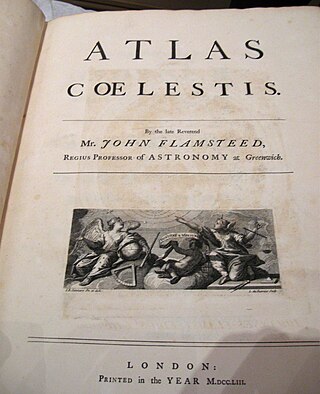
A constellation is an area on the celestial sphere in which a group of visible stars forms a perceived pattern or outline, typically representing an animal, mythological subject, or inanimate object.

Volans is a constellation in the southern sky. It represents a flying fish; its name is a shortened form of its original name, Piscis Volans. Volans was one of twelve constellations created by Petrus Plancius from the observations of Pieter Dirkszoon Keyser and Frederick de Houtman and it first appeared on a 35-cm (14") diameter celestial globe published in 1597 in Amsterdam by Plancius with Jodocus Hondius. The first depiction of this constellation in a celestial atlas was in Johann Bayer's Uranometria of 1603.

Columba is a faint constellation designated in the late sixteenth century, remaining in official use, with its rigid limits set in the 20th century. Its name is Latin for dove. It takes up 1.31% of the southern celestial hemisphere and is just south of Canis Major and Lepus.

Petrus Plancius was a Dutch-Flemish astronomer, cartographer and clergyman. He was born as Pieter Platevoet in Dranouter, now in Heuvelland, West Flanders. He studied theology in Germany and England. At the age of 24 he became a minister in the Dutch Reformed Church.

The Farnese Atlas is a 2nd-century AD Roman marble sculpture of Atlas holding up a celestial globe. Probably a copy of an earlier work of the Hellenistic period, it is the oldest extant statue of Atlas, a Titan of Greek mythology who is represented in earlier Greek vase painting, and the oldest known representation of the celestial spheres and the classical constellations. The sculpture is at the National Archaeological Museum of Naples, in Italy.

Noctua was a constellation near the tail of Hydra in the southern celestial hemisphere, but is no longer recognized. It was introduced by Alexander Jamieson in his 1822 work, A Celestial Atlas, and appeared in a derived collection of illustrated cards, Urania's Mirror. Now designated Asterism a, the owl was composed of the stars Sigma Librae, 4 Librae and 54–57 Hydrae, which range from 3rd to 6th magnitude.

Officina Typographica was a constellation located east of Sirius and Canis Major, north of Puppis, and south of Monoceros. It was drawn up by Johann Bode and Joseph Jérôme de Lalande in 1798, and included in the former's star atlas Uranographia in 1801, honouring the printing press of Johannes Gutenberg. Lalande reported wanting to honour French and German discoveries in the same manner that Nicolas-Louis de Lacaille had done for his new constellations. It was called Buchdrucker-Werkstatt by Bode initially, and later Atelier Typographique in the 1825 work Urania's Mirror, Atelier de l’Imprimeur by Preyssinger in 1862 and Antlia Typographiae in 1888.
Antonín Rükl was a Czech astronomer, cartographer, and author.

A star chart is a celestial map of the night sky with astronomical objects laid out on a grid system. They are used to identify and locate constellations, stars, nebulae, galaxies, and planets. They have been used for human navigation since time immemorial. Note that a star chart differs from an astronomical catalog, which is a listing or tabulation of astronomical objects for a particular purpose. Tools using a star chart include the astrolabe and planisphere.

Sidney Hall (1788?–1831) was a British engraver and cartographer well known and popular for his early nineteenth century atlases containing maps of the United Kingdom and of the ancient world reproduced from Hall's engravings. Hall made engravings for a number of international atlases at a time when cartography and atlases were very popular. He also engraved a series of cards for the various constellations, published c.1825 in a boxed set called Urania's Mirror.

NGC 14 is an irregular galaxy in the Pegasus constellation. It was included in Halton Arp's Atlas of Peculiar Galaxies, under the section "Galaxies with the appearance of fission," since the irregular appearance of this galaxy causes it to look like it is coming apart. It was discovered on September 18, 1786, by William Herschel.

NGC 15 is a spiral galaxy located in the Pegasus constellation. It was discovered by Albert Marth on October 30, 1864.

The Atlas Coelestis is a star atlas published posthumously in 1729, based on observations made by the First Astronomer Royal, John Flamsteed.

A Celestial Atlas, full title: A Celestial Atlas: Comprising A Systematic Display of the Heavens in a Series of Thirty Maps Illustrated by Scientific Description of their Contents, And accompanied by Catalogues of the Stars and Astronomical Exercises is a star atlas by British author Alexander Jamieson, published in 1822. The atlas includes 30 plates, 26 of which are constellation maps with a sinusoidal projection. In some editions the plates are hand-colored. The atlas includes three new constellations invented by Jamieson: Noctua, Norma Nilotica, and Solarium. Two celestial hemispheres of the atlas are centered on the equatorial poles via polar projection and geocentric alignment. The atlas comprises stars visible only to the naked eye, making it less cluttered.

NGC 507, also known as Arp 229, CGCG 502-67, MCG 5-4-44, PGC 5098, UGC 938, and V V 207, is a lenticular galaxy in the constellation Pisces. It was described as being "very faint", "pretty large", "round", "brighter in the middle", and "south of NGC 508" by John Dreyer in the New General Catalogue. The two galaxies are a part of the Atlas of Peculiar Galaxies, where NGC 507 is described as "Circular or near circular rings of small density difference."

NGC 497 is a barred spiral galaxy approximately 336 million light-years away from Earth in the constellation of Cetus. It was discovered by French astronomer Édouard Stephan on November 6, 1882.

NGC 510 is a double star in the constellation of Pisces. The stars are separated 8", and located 7' ESE of NGC 499 and 9' WNW of NGC 515.
NGC 4230 is a loosely scattered open cluster in the constellation of Centaurus. It was discovered by John Herschel on April 5, 1837.
















